Moving away from the words and onto the wards

Firstly, I’d like to wish you all a warm welcome to the final issue of Wounds International for 2019. It’s been a strange old year with Brexit continuing to dominate the headlines in the UK and beyond, to the point where most of us wish that the term ‘Brexit’ had never been uttered in the […]
Wounds digest

In this section, a brief synopsis is presented of a range of recently published articles that may be of interest to healthcare professionals working in the wound care setting. The aim of this round-up is to provide an overview, rather than a detailed summary and critique, of the research papers selected. Full references are provided […]
Updating clinical skills — 10 years on

For this editorial, I was asked to consider what has changed over the past 10 years since I published a review on the challenges associated with teaching clinical skills to improve wound management. My initial thoughts were that nothing much had changed but after a period of reflection and discussion with colleagues, it would seem […]
Incision care and dressing selection in surgical wounds: Findings from an international meeting of surgeons

This report highlights the findings of an international meeting of eight orthopaedic surgeons and one vascular surgeon, discussing incision care and dressing selection in surgical wounds. The meeting was held in London in July 2019 and was supported by Mölnlycke Health Care.
Patient Involvement — the big reveal

If you missed Wounds UK Annual conference 2019, you can view Prof. Kerry Reid-Searl, School of Nursing, Midwifery, Central Queenslamd University, Australia. discuss patient involvement.
Made Easy: Zetuvit Plus Silicone Border

Exudate plays a key role in wound healing, yet appropriate exudate management poses a significant challenge in clinical practice. Exudate in excess requires frequent dressing changes and nursing visits, resulting in pain, inconvenience and anxiety for patients and high healthcare-associated costs. This Made Easy focuses on the use of the atraumatic superabsorbent polymer (SAP) dressing […]
Effects of manual lymph drainage on lymphoedema and dysphagia in head and neck cancer: a case series
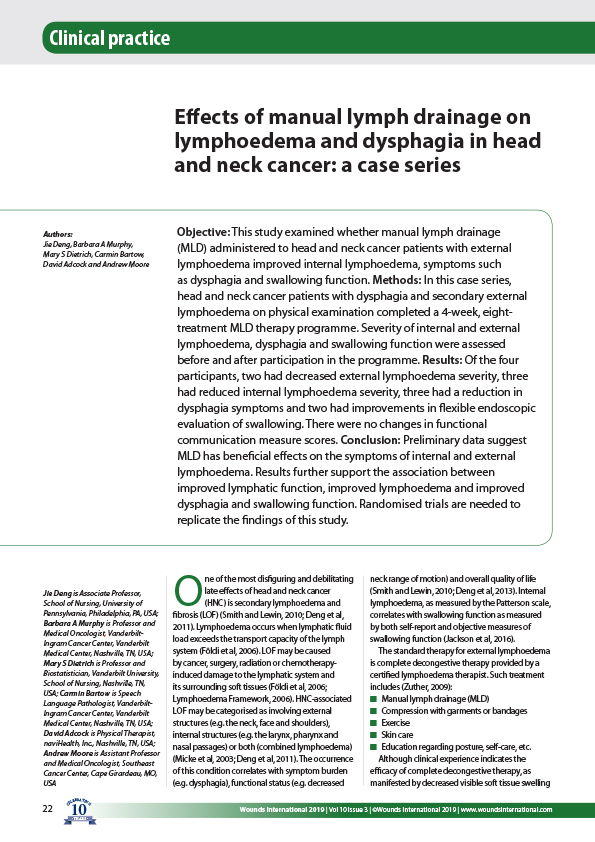
Objective: This study examined whether manual lymph drainage (MLD) administered to head and neck cancer patients with external lymphoedema improved internal lymphoedema, symptoms such as dysphagia and swallowing function. Methods: In this case series, head and neck cancer patients with dysphagia and secondary external lymphoedema on physical examination completed a 4-week, eighttreatment MLD therapy programme. Severity of internal […]
Applying Unna boot bandages with high pressure: Fischer bandages

Unna boot bandages are still widely used around the world. They are popular, inelastic bandages, mostly applied with moderate or low pressure (20– 30 mmHg). It is demonstrated that higher compression pressure (initially 50– 70 mmHg in the resting position) has considerably stronger haemodynamic effects, making this so-called ‘Fischer’ bandage a suitable choice for patients […]
A focus on the Triangle of Wound Assessment — addressing the gap challenge and identifying suspected biofilm in clinical practice
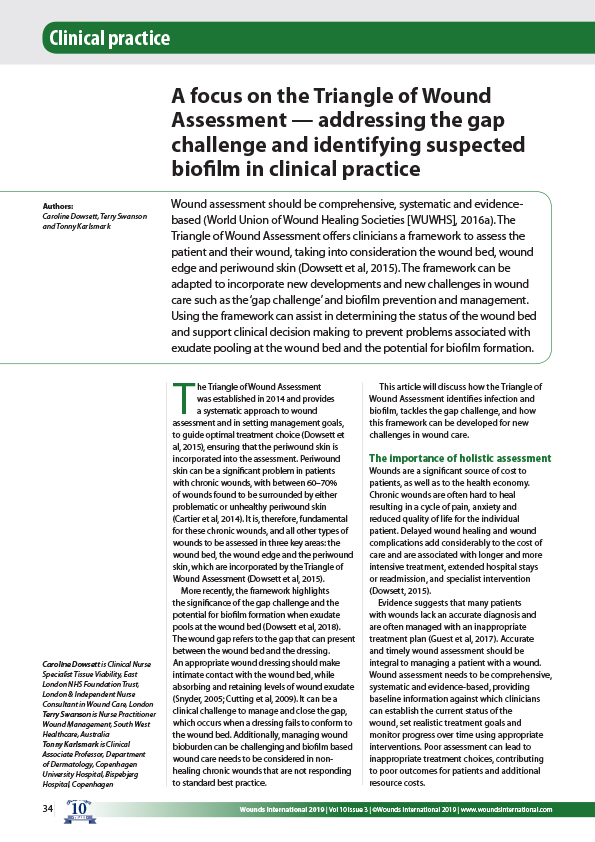
Wound assessment should be comprehensive, systematic and evidencebased (World Union of Wound Healing Societies [WUWHS], 2016a). The Triangle of Wound Assessment offers clinicians a framework to assess the patient and their wound, taking into consideration the wound bed, wound edge and periwound skin (Dowsett et al, 2015). The framework can be adapted to incorporate new […]
Using the new T.I.M.E. Clinical Decision Support Tool to promote consistent holistic wound management and eliminate variation in practice: Part 2 at the Sygehus Sønderjylland Hospital, Sønderborg, Denmark
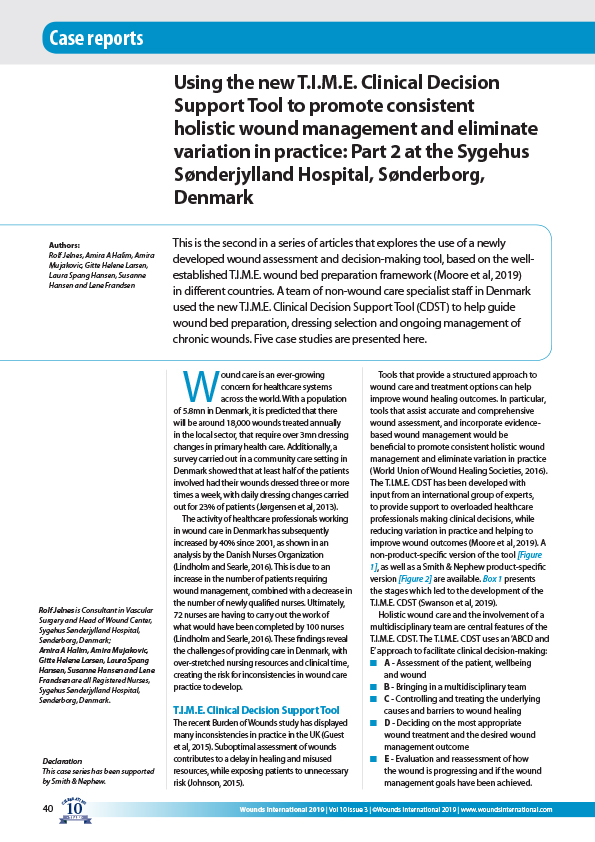
This is the second in a series of articles that explores the use of a newly developed wound assessment and decision-making tool, based on the well-established T.I.M.E. wound bed preparation framework (Moore et al, 2019) in different countries. A team of non-wound care specialist staff in Denmark used the new T.I.M.E. Clinical Decision Support Tool […]
Using the new T.I.M.E. Clinical Decision Support Tool to promote consistent holistic wound management and eliminate variation in practice: Part 3 at the West Park Healthcare Centre, Chronic Care and Rehabilitation Hospital, Canada

This is the third in a series of articles that explores the use of a newly developed wound assessment and decision-making tool, the T.I.M.E. Clinical Decision Support Tool (CDST) (Moore et al, 2019) based on the wellestablished T.I.M.E. wound bed preparation framework (Schultz et al, 2003) in different countries and settings. A team of non-wound […]
Traditional and single use NPWT: when to use and how to decide on the appropriate use? Recommendations of an expert panel

Negative pressure wound therapy (NPWT) is a concept that has been around for over 20 years. There is now more choice, potential and possibilities for the use of the NPWT for different indications. An international group of specialist surgeons with a high level of experience of NPWT in various wound types convened to discuss the […]
Photobiomodulation with Blue Light in non-healing wounds: case series evaluation
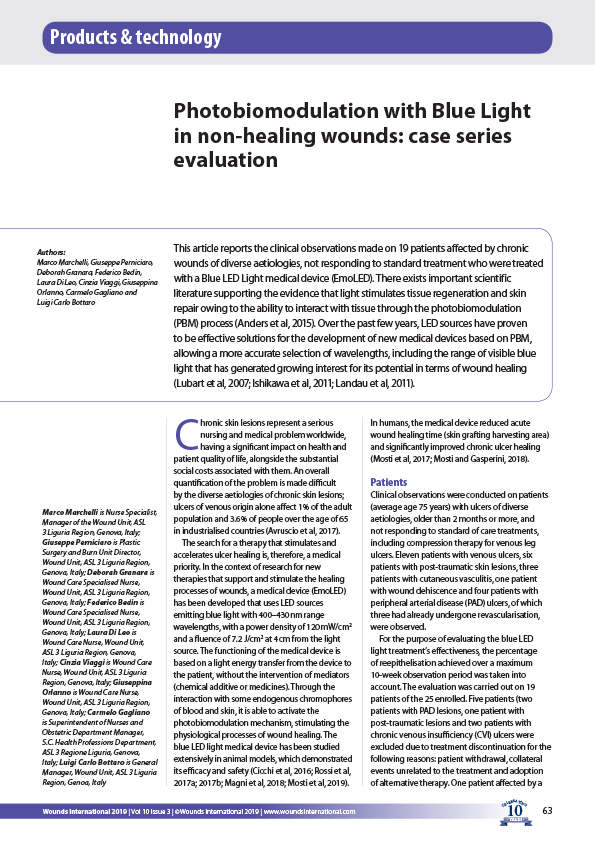
This article reports the clinical observations made on 19 patients affected by chronic wounds of diverse aetiologies, not responding to standard treatment who were treated with a Blue LED Light medical device (EmoLED). There exists important scientific literature supporting the evidence that light stimulates tissue regeneration and skin repair owing to the ability to interact […]
Meeting report: Promoting wound healing by optimising dressing change frequency

This report outlines the proceedings of a symposium, which took place at the European Wound Management Association conference in Gothenburg, Sweden, on June 5, 2019. The session explored the concept and themes of undisturbed wound healing and the key considerations that should guide its practical application and improve outcomes, with case studies involving the use […]
Meeting report: Addressing risk factors with evidence-based technologies for the prevention and treatment of pressure injuries in different healthcare settings

Implementing evidence-based strategies for the prevention and treatment of pressure injuries (PIs, also called pressure ulcers) that include the use of dressings, positioners, and turning and positioning systems can deliver optimal, cost-effective care to at-risk patients. This meeting report summarises the proceedings of an expert panel-led symposium at the European Wound Management Association (EWMA) Conference, […]
Wounds digest

In this section, a brief synopsis is presented of a range of recently published articles that may be of interest to healthcare professionals working in the wound care setting. The aim of this round-up is to provide an overview, rather than a detailed summary and critique, of the research papers selected. Full references are provided […]
Consensus document: Role of dressings in pressure ulcer prevention

Recognition of the huge economic, health-related and social burden of pressure ulcers has resulted in considerable efforts to reduce their occurrence. Despite this, pressure ulcers still occur. In recent years, evidence has been building that some types of dressings typically used to treat open wounds have the potential to supplement standard pressure ulcer prevention measures […]
Time to get our priorities straight

Chronic wounds are high on the healthcare agendas across the globe, but should they be even higher? The NHS in the UK spends a total of £5bn per year treating chronic wounds (Campbell, 2019) and there are an estimated 2.2mn people currently living with non-healing wounds in the UK (Guest et al, 2015). Untreated chronic […]
Some innovations during my journey through podiatry

For most of the practicing physicians in India, entering practice medicine either occurs when they do not secure a government job or when they retire from the service. I might be an exception to this rule since I resigned from my class I central government job in North-Eastern Railways after just 3 months, at 27 […]
Ten top tips: wound photo documentation

Wound images provide a visual reference that is not matched by memory or the written word (Swann, 2010). Wound photography communicates a universal language that can easily translate across the continuum of care and to the stakeholders involved (patient, family/carers, healthcare professionals and the agencies funding treatment). Wound images can provide a timeline for plotting […]
An observational study of the surgical site infection rate in a General Surgery Department at a General Hospital in Malaysia

Background: Surgical site infection (SSI) is one of the most common healthcare-associated infections globally. A consequence of infection is wound dehiscence with an associated high mortality rate. Method: A surveillance study of SSI was undertaken in a Surgical Department of a General Hospital in East Malaysia to determine the SSI incidence and to identify the risk factors […]
Biofilm-based wound care with cadexomer iodine: Made Easy

Evidence suggests that biofilms are present in most, if not all, chronic, non-healing wounds with a recent in vivo study suggesting prevalence could be at least 78% (Malone et al, 2017a). This Made Easy informs clinicians about the role of cadexomer iodine, an effective anti-biofilm dressing, as an early intervention within the T.I.M.E (Schultz, 2003) […]
Made Easy: MORE THAN SILVER™ Technology

Biofilm is a primary cause of wound chronicity (Høiby et al, 2015; Wolcott et al, 2016; Wolcott, 2017), and is characterised by recurrent inflammation and poor response to antimicrobial therapies (Høiby et al, 2015; Wolcott et al, 2016; Wolcott, 2017). The results of a systematic review and meta-analysis (Malone et al, 2017) confirm biofilm […]
WUWHS Position document: Skin graft donor site management in the treatment of burns and hard-to-heal wounds

Patients undergoing skin grafting procedures will require wound management of both the actual skin graft and the donor site from where it has been removed – these two wounds require specific management and present very different challenges in practice. The management of donor site wounds is of particular importance, as the process involves the creation […]
WUWHS Position document: Skin graft donor site management in the treatment of burns and hard-to-heal wounds

Patients undergoing skin grafting procedures will require wound management of both the actual skin graft and the donor site from where it has been removed – these two wounds require specific management and present very different challenges in practice. The management of donor site wounds is of particular importance, as the process involves the creation […]
Retrospective case studies evaluation: BETAplast® PRO-N dressing

This document contains a series of case reports describing the use of BETAplast® PRO-N Dressing in patients with a range of chronic and acute wounds of varying aetiology and severity. Each case study was carried out for a period of 1 month, or longer, with regular assessments. A photographic record of the wound was also […]
Complex physical therapy for sclerodermalike skin induration induced by taxanebased anticancer agents in a lymphoedema case after breast cancer surgery
Scleroderma-like skin induration (SLSI) induced by taxane-based anticancer agents is an adverse effect of chemotherapy that typically affects the extremities, especially the lower legs. Skin induration often remains after chemotherapy is complete, with a significant decrease in the patient’s quality of life and the potential for severe restrictions in joint mobility. Treatment options are limited […]
Debilitating chronic veno-lymphoedema: using a muscle pump activator medical device to heal wounds and improve skin integrity
This case study describes the experience of adding a muscle pump activator medical device (geko™, Firstkind) to the care of a 66-year-old male with veno-lymphoedema and chronic renal failure, causing lower leg blistering resulting in wounds. He had received daily or twice daily dressing changes with frequent infections for 5 years, with bilateral amputation and […]
A diagnostic dilemma: aetiological diagnosis of lymphoedema patients at an Indian multidisciplinary meeting
Lymphatic filariasis (LF) is caused by a mosquito-transmitted infection. The morbidity of this infection can result in chronic, progressive lymphoedema. LF is recognised as one of the most common causes of lymphoedema worldwide with an estimated 40 million people affected. In India, LF is considered endemic with people at risk from across 250 districts. The […]
The delivery of lymphoedema care to patients in the end stages of life: key factors and their potential to influence practice
Underpinned by her experience as a lymphoedema clinical nurse specialist, the author provides an overview of the key factors and their influence on the delivery of quality lymphoedema care to patients in the end stages of life. The account is described from the perspective of the lymphoedema practitioner, the delivery model of National Health Service […]
Feeling the pressure: how can we be sure we are getting it right?
The application of compression is a mainstay in the treatment of acute and chronic oedema and lymphoedema (Moffatt et al, 2012; Scheer, 2017), as well as in some of their associated comorbidities, such as ulcers (Dumville et al, 2015). We do not always make a clear diagnosis prior to starting treatment and, therefore, do not […]
Medicine and Body Image: Resource Planning for the Poor. A Memoir by Terence Ryan
It takes courage to disclose all one’s faults, failures, shortcomings and disabilities, but these set the context for a progressive communicative thinker, speaker, initiator and leader, Professor Terence Ryan, and his book on medicine and body image.
Selected abstracts from the 8th Joint International Lymphoedema Framework Conference, Rotterdam, 2018
These abstracts have been selected because we believe they represent a combination of leading edge information or are likely to be of current interest generally or represent a unique solution to a particular problem or issue. We hope you enjoy reading them.
Obesity, inflammation, diet, gut microbes and lymphatic system communications with the brain
The gut and its wall is like the skin — a barrier between our internal and the external environment. Often, all is well and the barrier is structurally sound and functions as it should. However, sometimes things can go wrong and these aberrations can become chronic. It’s not an impermeable barrier; many things have to […]
A review of the literature relating to liposuction in women with lipoedema and Dercum’s disease
This paper reports on a review of the literature on liposuction for women with lipoedema and those with Dercum’s disease. The aims were: to identify the outcomes from liposuction in these two groups; and describe adverse effects reported in the studies. A total of 10 studies met the inclusion and exclusion criteria, dated between 2006–2019. […]
The utilisation of prospective surveillance with bioelectrical impedance for early detection and instigation of treatment for breast cancer-related lymphoedema
Introduction: Patients undergoing axillary surgery for breast cancer treatment are at risk of developing upper limb lymphoedema. Early detection and initiation of treatment can reduce the incidence of clinically significant disease. Bioimpedance spectroscopy (BIS) can be used to identify increased extracellular fluid volume. Aim: The aim of this study was to determine the rates of lymphoedema by BIS […]
Lymphoedema therapists: a national and international survey
The American Lymphedema Framework Project (AFLP) surveyed lymphoedema therapists in the US in 2009 to describe their preparation, patient population and care practices. In the autumn of 2018, the survey was expanded to trained therapists worldwide to describe and compare current and past therapist characteristics and practices. The updated 2009 survey was distributed via Qualtrics […]
Genital lymphoedema: pathology, reconstruction and outcomes
Background: Penile and scrotal lymphoedema is a debilitating complication following lymph node dissection, radiation, or in the setting of obesity. Treatment is aimed at improving cosmesis and reducing urologic complications. Aims: To describe our experience with the surgical correction of peno-scrotal lymphoedema. Methods: A retrospective review of all patients who underwent surgical treatment for penoscrotal lymphoedema was performed. Comorbidities, technical approaches and functional outcomes were […]
Impact of lymphovenous anastomosis on limb circumference in patients with lymphoedema tarda
Lymphoedema tarda is thought to result from congenitally deficient lymphatic reserve. Incompetent lymphatic valves lead to local failure of the lymphatic system and reduce the ability of the remaining lymphatics to drain lymph, leading to late-onset chronic lymphoedema. In this study, eight patients with lower-limb lymphoedema with obstructed lymphatics diagnosed by lymphoscintigraphy underwent lymphovenous anastomosis. Participants’ initial limb […]
Understanding the acceptability and feasibility of a regional lymphoedema surveillance programme: a pilot study
Background: Lymphoedema is a common complication for breast cancer survivors. Early detection and treatment reduces costs and improves outcomes. Aim: To determine the acceptability and feasibility of a lymphoedema surveillance programme (LSP) for breast cancer patients and breast clinic staff in rural and regional areas. Methods: All patients diagnosed with breast cancer were invited to participate. Data collected prior to surgery included […]
Developing key performance indicators for a lymphoedema service in Ireland using a classic Delphi technique
Introduction: This is a unique study and a first for lymphedema services in the Republic of Ireland as relevant national key performance indicators (KPIs) do not exist currently. Aim: To identify and develop KPIs for lymphoedema services in Ireland, using a classic Delphi Technique. Methods: A two-round classic Delphi technique was used to achieve consensus, initially among an Expert Panel of national and international […]
Incidence of and risk factors for arm lymphoedema following breast cancer treatment: a study in Ghana
Objective: is research aims to determine the incidence and risk factors of lymphedema after breast cancer treatment at the oncology unit of a hospital in Kumasi, Ghana. Methods: A descriptive, retrospective survey was used in this study. Breast cancer and lymphoedema-related variables were collected from the medical records of breast cancer patients. Data were analysed […]
Managing skin tears in practice

Skin tears are acute wounds that can be painful and affect patient quality of life. This Quick Guide provides practical information on how to identify and assess skin tears, risk assessment, step-by-step management and a practical guide to dressing selection in practice. Supported by KCI – An Acelity Company.
Stem cells and growth factors in healing the diabetic foot ulcer

Living with a chronic wound — an update of an ongoing project by the European Wound Management Association
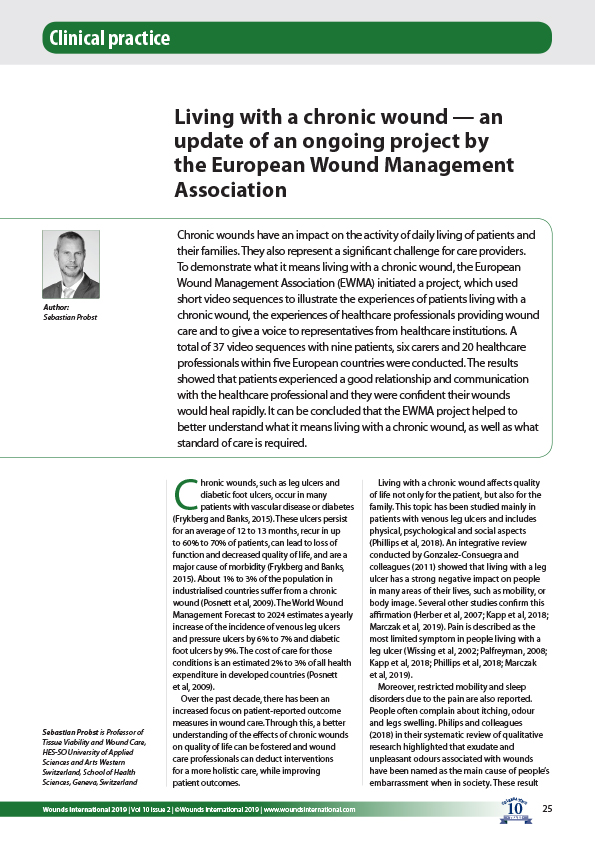
Using the new T.I.M.E. Clinical Decision Support Tool to promote consistent holistic wound management and eliminate variation in practice at the Cambourne Medical Clinic, Australia: Part 1

Undisturbed wound healing: a narrative review of the literature and clinical considerations

Understanding undisturbed wound healing in clinical practice — a global survey of healthcare professionals

Wounds digest

Made Easy: PolyMem and Countering Inflammation

Inflammation is the result of the immune system’s response to localised damage. Acute inflammation results in local redness, heat, swelling and pain and resolves once the cellular debris and any foreign materials have been removed from the area. This is a normal, healthy response to exogenous cell death or tissue injury that is essential for […]


